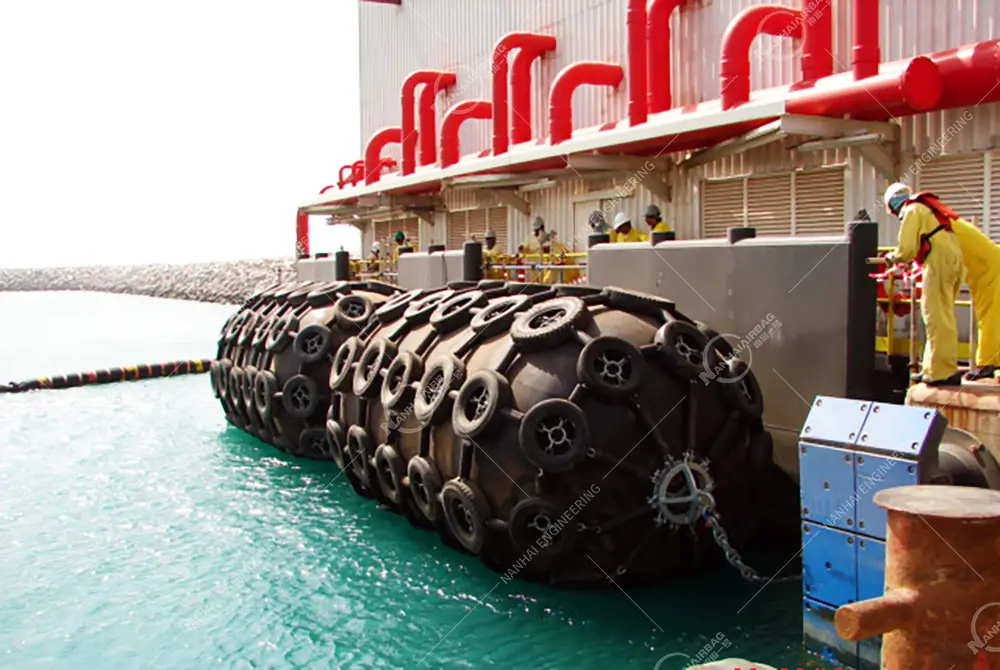How to store pneumatic fenders ?
07/18/2025Application of foam fenders in docks and dry docks
07/21/2025What Causes Damage to Pneumatic Fenders?
Pneumatic fenders—those big floating air cushions used in ship‑to‑ship (STS) and ship‑to‑berth operations—can suffer damage for several key reasons:
- Overloading / excess pressure: When a vessel strikes too hard or carries more momentum than expected, internal air pressure may spike or drop unpredictably, stressing the fender’s rubber shell.
- Friction & shear forces: High tangential contact, especially during docking at angles or in currents, causes surface abrasions, corner cuts/cracks, and net damage.
- Poor anchoring or attachments: Corroded chains, anchors, and hardware can fail, leading to dislodgement or improper loading that damages the fender.
- Environmental wear & aging: Sun, temperature extremes, ozone, and marine growth degrade rubber and nets. UV and salty air gradually make materials brittle.
- Low-quality manufacturing: Fenders made with inferior materials or improper methods (e.g., wrapped vs. molded) are prone to delamination and early failures under critical stress.

Why Is Understanding This Urgent?
Modern ports demand reliability—and NANHAI fenders are trusted worldwide—but downtime is costly. Imagine:
- A tanker berthing at an angle in gusty winds. The fender shreds from shear damage.
- A tugboat slips against the fender due to low air pressure, causing extreme deformation.
- Corroded hardware fails during impact, causing fender displacement and hull damage.
Preventing these, rather than reacting to them, is vital—especially for high‑turnover terminals and long‑shore operations.
Quick Fixes and Preventive Measures
- Maintain correct internal pressure within the specified range—e.g., 50–80 kPa for STS use—and check it regularly.
- Inspect surface wear daily: Look for cuts, abrasions, net damage, and signs of soil or marine growth.
- Service connections routinely: Clean, re‑paint, or replace corroded chains, shackles, and netting hardware.
- Protect from climate: Shield idle fenders from UV and heat, especially if stored for years.
- Choose quality: Use fenders built to ISO 17357 standards via proper molding—avoid cheaper wrapped‑type manufacturing.
Featured Snippets
The damage begins when pneumatic fenders are over-pressurized or under-pressurized, leading to deformations and potential shell failure.
Excess friction during angled berthing, currents, or waves causes surface abrasions and cuts on the fender’s rubber or net.
Corrosion in anchoring hardware strains load points, potentially displacing or tearing the fender.
Aging from UV, ozone, salt, and temperature extremes gradually weakens rubber integrity over time.
Continue Reading—Protect Your Investment!
- Learn how NANHAI designs durable fenders that resist shear and impact.
- Get our step‑by‑step guide to daily, monthly, and yearly inspections.
- See how proper storage and net rejuvenation extend lifespan.
- We use ISO 17357‑compliant molding, not wrapped shortcuts.
FAQ
What pressure should pneumatic fenders be maintained at?
Internal pressures typically range from 50–80 kPa for STS usage—specific values depend on diameter and manufacturer specs. Low or high pressure leads to performance loss and damage.
How often should I inspect pneumatic fenders?
Daily visual checks (wear, net condition), monthly hardware inspections, and annual comprehensive reviews are industry best practices.
Can shear friction during berthing ruin pneumatic fenders?
Yes—when vessels move sideways at contact, friction causes abrasions, cuts, and tearing of rubber or net, especially during angled or current-influenced mooring.
Do UV and temperature extremes damage rubber fenders?
Absolutely—UV, salt spray, ozone, and heat/cold cycles make rubber brittle, leading to cracking, net weakening, and accelerated aging.
Are all pneumatic fenders made the same?
No—ISO‑compliant molded fenders are stronger and more reliable than cheaper wrapped‑type ones, which may fail under stress or harsh conditions.
Let NANHAI Help You Stay Ahead
By combining robust manufacturing, routine inspections, and smart maintenance strategies, you safeguard vessels and wharves—and maintain smooth operations. Want a custom inspection plan or quotes on durable ISO‑standard pneumatic fenders? Contact NANHAI today—and keep your berthing systems damage-free and reliable.
